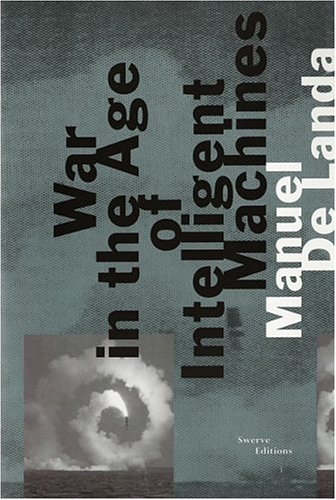Manuel DeLanda: War in the Age of Intelligent Machines (1991)
Filed under book | Tags: · abstract machine, arpanet, artificial intelligence, expert systems, machine, military, robots, technology, turing machine, war

“In the aftermath of the methodical destruction of Iraq during the Persian Gulf War, the power and efficiency of new computerized weapons and surveillance technology have become chillingly apparent. For Manuel De Landa, however, this new weaponry has a significance that goes far beyond military applications: he shows how it represents a profound historical shift in the relation of human beings both to machines and to information. The recent emergence of “intelligent” and autonomous bombs and missiles equipped with artificial perception and decision-making capabilities is, for De Landa, part of a much larger transfer of cognitive structures from humans to machines in the late twentieth century.
In this remarkable book, De Landa provides a rich panorama of these astonishing developments. He details the mutating history of information analysis and machinic organization from the mobile siege artillery of the Renaissance, the clockwork armies of the Thirty Years War, the Napoleonic campaigns, and the Nazi blitzkrieg up to present-day cybernetic battle-management systems and satellite reconnaissance networks. Much more than a history of warfare, De Landa provides an unprecedented philosophical and historical reflection on the changing forms through which human bodies and materials are combined, organized, deployed, and made effective.”
Publisher Zone Books, 1991
ISBN 0942299752
271 pages
PDF (15 MB, updated on 2016-7-18)
Comment (0)Alex Roland, Philip Shiman: Strategic Computing: DARPA and the Quest for Machine Intelligence, 1983-1993 (2002)
Filed under book | Tags: · 1980s, arpanet, artificial intelligence, computing, expert systems, history of computing, history of technology, technology

“This is the story of an extraordinary effort by the U.S. Department of Defense to hasten the advent of “machines that think.” From 1983 to 1993, the Defense Advanced Research Projects Agency (DARPA) spent an extra $1 billion on computer research aimed at achieving artificial intelligence. The Strategic Computing Initiative (SCI) was conceived as an integrated plan to promote computer chip design and manufacture, computer architecture, and artificial intelligence software. What distinguished SCI from other large-scale technology programs was that it self-consciously set out to advance an entire research front. The SCI succeeded in fostering significant technological successes, even though it never achieved machine intelligence. The goal provided a powerful organizing principle for a suite of related research programs, but it did not solve the problem of coordinating these programs. In retrospect, it is hard to see how it could have.
In Strategic Computing, Alex Roland and Philip Shiman uncover the roles played in the SCI by technology, individuals, and social and political forces. They explore DARPA culture, especially the information processing culture within the agency, and they evaluate the SCI’s accomplishments and set them in the context of overall computer development during this period. Their book is an important contribution to our understanding of the complex sources of contemporary computing.”
Keywords and phrases
DARPA, expert systems, Teknowledge, Connection Machine, Shiman, Robert Kahn, supercomputers, ARPA, IntelliCorp, Artificial Intelligence, Lynn Conway, VLSI, ARPANET, Alex Roland, U.S. Congress, Saul Amarel, CPSR, George Heilmeier, Xerox PARC, Craig Fields
Publisher MIT Press, 2002
ISBN 0262182262, 9780262182263
427 pages
PDF (updated on 2012-7-25)
Comment (1)
